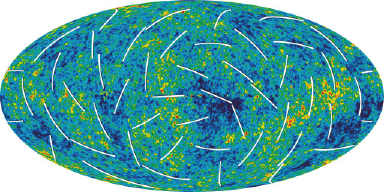As promised, the team behind the WMAP (Wilkinson Microwave Anisotropy Probe) satellite have released their lovely new results. WMAP measures fluctuations in the CMB (which I’ve already written about a lot), and in 2003 they released high-resolution, high-sensitivity maps of the CMB over the whole sky. Today, they updated those maps, and also released new maps of the CMB polarization: the CMB is made of photons (light) and light can be characterised not just by its intensity (the color in the map below), but also by its polarization, which you can think of as a little arrow that travels along with it (normally, those lines average to zero, but if you have polarized sunglasses, you already know that sometimes, when light reflects off of something like the surface of a pool of water, it gets polarized). When the photons that become the CMB scatter off of electrons in the early universe, they too can end up with a small net polarization, due to the same physics that produces the temperature fluctuations in the first place (there are other, even more exciting, ways of producing polarization that may let us probe even earlier times and the epoch of cosmological inflation that we believe may be responsible for the large-scale structure of the Universe today, but WMAP doesn’t have the sensitivity to see that sort of polarization signal).

[Courtesy of the NASA/WMAP Science Team]
Of course there’s much more science to discuss: what does it mean? What’s changed since the last data release? (For one thing, some of the most interesting results, such as the epoch of formation of the first bright objects, seem to have been softened somewhat.) More later.
Update: It’s too late for me to expound much on the results, but the NY Times lets the great and the good (of the cosmology set) have their say, and for more real commentary, please check out Sean Carroll and Steinn Sigurdsson (twice!), and, as we say, references therein.